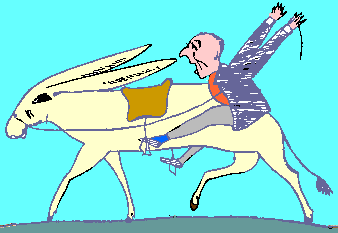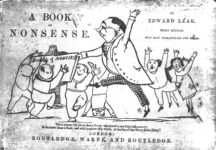^
Born on 29 January 1627: Jan
Siberechts (or Sibrechts), Flemish landscape painter who
died in 1703.
— Siberechts settled in England in the early 1670s. His landscapes
are somewhat Rubensian, but he is best known for his "portraits" of English
country houses, done in a simple, rather archaic manner; two views of Longleat,
Wiltshire (1675 and 1676), are still preserved in the house. He was the
first professional exponent of the genre.
—LINKS
— Crossing
a Creek (1669, 94x116cm) _ In Flemish genre painting the representation
of country life remained somewhat conventional. The exceptionally vigorous
naturalism with which Jan Siberechts rendered landscapes and peasants makes
one think of Courbet.
— The
Market Garden (1664, 158x241cm) _ A farmyard in front of a well-appointed
farmhouse, which rises up centrally in the background, with to the right
a well and a small barn, and to the left in the distance a vegetable garden
and a rural hamlet around a church, all set the scene for the busy occupations
of the countryfolk in the foreground. Three women are preparing their vegetable
harvest for market, assisted in the right background by a waggoner and watched
on the left by a friendly-looking dog and a maid with a milking pail on
her head and a pot with a handle in her hand. Behind her a peasant woman
is letting cattle out of the barn whilst a lad is driving towards the herd
a couple of sheep that have strayed into this attractive tableau, producing
a light-hearted anecdote that links the various planes. The motif of the
poster announcing the sale of the farm introduces a hint of uncertainty
and of impending doom.
Even so, the general impression of Siberechts'
composition is that of an undisturbable natural order and rural calm. In
doing so he touches a sensitive chord with the modern city-dweller. Country
life already exercised a particular attraction on the painter's contemporaries,
leading to the building of many country houses away from the cities. The
dignity with which the country-folk are depicted is typical of Siberechts.
There is no longer any hint of "boorish" behaviour - a proverbial term for
the low appreciation in which a civilised bourgeoisie held country people
and which expressed its dislike in many a vituperative tableau. Siberechts'
noble peasants are often compared with those of France's Le Nain brothers
Antoine
Le Nain [1600-1648], Louis
Le Nain [1603-1648], Mathieu
Le Nain “le Chevalier” [1607- 20 Apr 1677].
Possibly Siberechts drew inspiration for
his noble portrayal from Brussels painter Michael
Sweerts. For the motifs, such as the milkmaid carrying her heavy pail
on her head, the reader is referred to her counterpart in Rubens' late landscapes.
When it comes to the sculptural stateliness of Siberecht's figures, we should
not forget that his father was a sculptor. This painting, the theme of which
departs from his more usual "Landscapes with Fords", came into being in
his Antwerp period, before the artist entered the service of the English
aristocracy. An analogous work, the Farmyard, dated from 1662, is also conserved
in the Brussels museum.
— Landscape
with Rainbow, Henley-on-Thames (1690, 82x103cm) _ Even in its later
period, Flemish landscape painting retains the main distinguishing characteristics
that emerged as early· as the 16th century in the works of such atrists
as Pieter
Brueghel and Momper.
This painting shows a sweeping view from a slightly elevated position, sloping
down over the cattle pastures in the foreground towards a river plied by
a cargo boat on the left and with a village on its banks to the right. Towards
the background, the terrain slopes upwards again, with fields under changing
sunlight and clouds, and a double rainbow in the sky. On the left, the view
broadens out into the background towards the hills on the horizon. A Dutch
landscape painting, for example by Ruisdael,
could hardly be described in this manner. Unlike Flemish landscape paintings.
their Dutch counterparts rarely include so many different and contrasting
elements. Here, we have proximity and distance, hill and plain, animals,
people, boats and houses. While Flemish landscapes frequently have a universal
theme, Dutch landscapes tend to concentrate on a single aspect. This painting
is typical of the later work of Sibcrechts, who emigrated to England in1672.
Whereas his Flemish landscapes generally portray a small detail, his later
work is topographically more precise; on the right we can recognize the
village of Henley-on-Thames.
— The
Wager (1665, 120x160cm) _ The dynamic, cosmic vision in the tradition
of Rubens
is absent from Jan Siberechts' The Wager. The artist was seduced
by Dutch landscape art with its lightness of touch, and clear, impressionistic
atmosphere. Siberechts' paintings have, however, a certain solidity of form
and evenness of execution. |
 ^ Died
on 29 January 1888: Edward Lear,
England, landscape painter, writer of nonsense verse, born on 12 May
1812. ^top^
^ Died
on 29 January 1888: Edward Lear,
England, landscape painter, writer of nonsense verse, born on 12 May
1812. ^top^  1923
Elihu Vedder, US Symbolist
painter born on 26 February 1836. — LINKS
— Death
of Abel (The Dead Abel)..., (1869) — The
Sphinx of the Seashore (1879) — Dominicans.
A Convent Garden, near... (1859) — Bed
of the Torrent Mugnone, near..., (1864) —
The Rescue (Tennyson study for wood... (1864)
1923
Elihu Vedder, US Symbolist
painter born on 26 February 1836. — LINKS
— Death
of Abel (The Dead Abel)..., (1869) — The
Sphinx of the Seashore (1879) — Dominicans.
A Convent Garden, near... (1859) — Bed
of the Torrent Mugnone, near..., (1864) —
The Rescue (Tennyson study for wood... (1864)